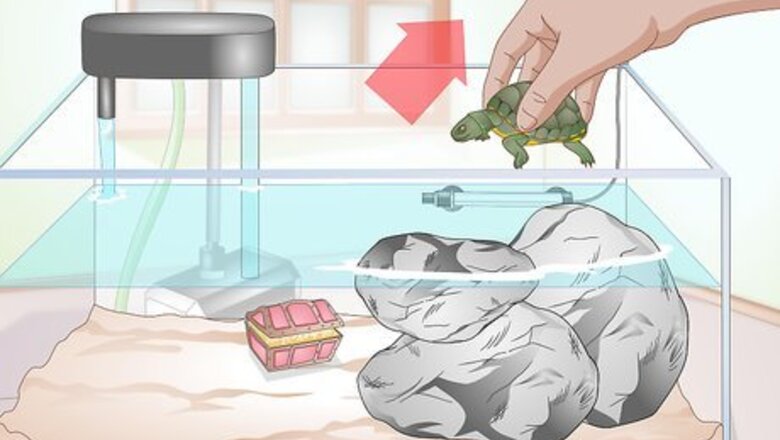
views
Readying Your Tank For Cleaning
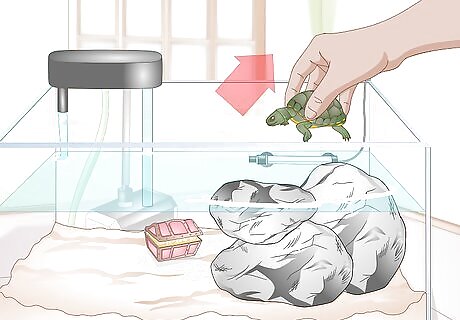
Transplant the turtle. Pick it up gently from the tank, and set it in a bucket, bowl, or the carrying case you brought it home in from the pet store. In this other container, put both enough water for swimming, and enough material--such as peat or rocks--to allow the turtle something to climb on. And for sanitary reasons, don’t use this secondary container for anything else but a temporary home for your turtle. Use a transplant container large enough to allow the turtle to be able to turn around while swimming. A transparent container is preferable.
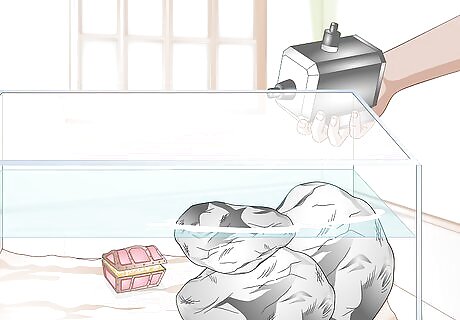
Remove filters and heaters. Unplug and then remove the tank’s electric devices, and place them in a sink or bucket for cleaning. Remember where the devices were located for when you need to put them back. Keeping the same setup as before will avoid disorienting your turtle.

Take out large objects. One by one, remove any plastic or live plants, large rocks, or pieces of wood. Place them in a separate bucket that you will use only for this purpose, for sanitary reasons. Or if you decide to clean the tank in a bathtub, you can place them aside in the tub.
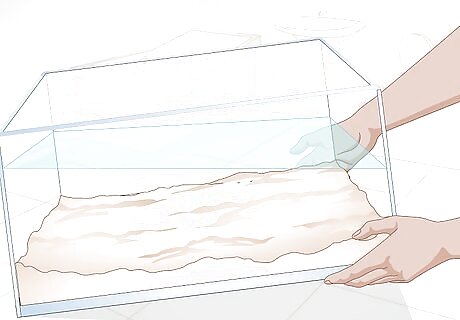
Move the tank to a cleaning area. Depending on how far you can carry the tank, either outside in a grassy area, or in a bathtub are good cleaning areas. Never try to carry a tank by yourself: be sure to ask someone, preferably an adult, to help you carry the tank. Position yourselves on opposite ends of the short sides of the tank, slide it slowly to the edge of its table, and pick it up from below with both hands.
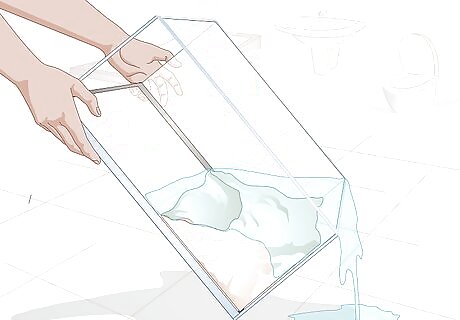
Empty all the water. Lift one end of the tank until the water pours out completely. Ask someone to help you lift it if the tank is too heavy for you. Lift the tank from a squatting position, extending your legs, instead of standing over it and trying to lift it with just your arms and back. If you have a substrate of small, gravelly rocks, you can leave those in the tank. If your substrate is some kind of organic matter such as peat or nut shells, discard and replace these during each cleaning.
Scrubbing and Rinsing the Tank and its Contents
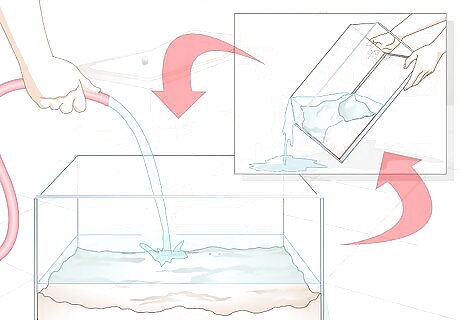
Rinse the substrate. Using either a garden hose or the bathtub faucet, fill the tank to about ¼ full with water, then empty it fully. Repeat this about five times, until the water in the tank is considerably clearer than when you started. To empty the tank, lift it slowly at one end from a squatting position, extending your legs to lift the tank instead of lifting with your arms and back muscles. The tank should be almost in a vertical position before all the water drains out. Ask someone, preferably an adult, to help you lift the tank if it is too heavy for you.
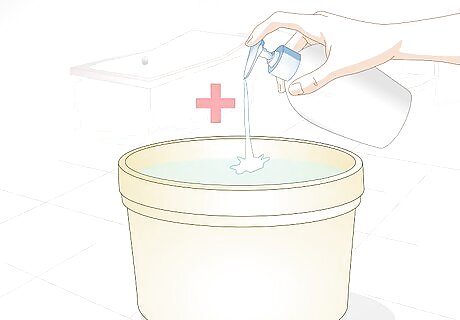
Prepare a cleaning solution. Make a mixture of 0.5 cups (0.1 L) of chlorine bleach for every 1 gallon (3.8 L) of water. Or combine ⁄4 cup (0.1 L) of plain distilled white vinegar with 1 gallon (3.8 L) of water. If you'll be doing the cleaning on a lawn or in an area near other vegetation, don’t use bleach or vinegar cleaning solutions, since these will kill plants. Instead, find a biodegradable, plant-friendly tank cleaner at the pet store. Never use household cleaner, detergent, or disinfecting agent like dish or hand soap (Lysol, Comet, etc.) since the chemical residue is difficult to fully remove. If the odor of chlorine or vinegar bothers you, check the pet store for a turtle-safe tank cleaner. Make sure to choose a plant-friendly, biodegradable one if you’ll be cleaning outdoors near plants.
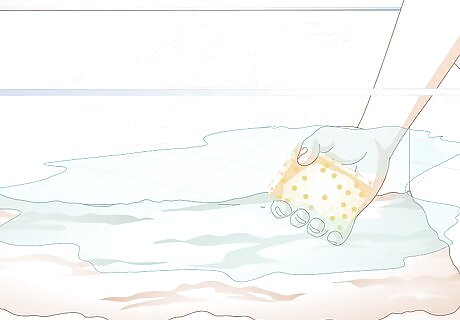
Scrub the tank. Dip a sponge or coarse rag in the cleaning solution. Scrub all sides of the tank, including the bottom, making sure to pay special attention to the corners and spaces where two panels come together. Debris tends to build up and get caught easier in these areas. To keep the substrate out of the way, tilt the tank to one side so the rocks fall to that side. Scrub everything except the rocks, then tilt the tank to the other side and repeat the process. Finally, scrub the substrate as well.
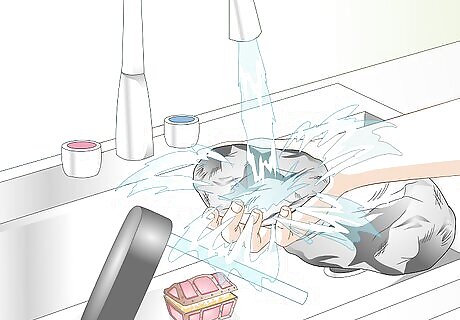
Clean the devices and decorations. Take apart the filter according to its instruction manual, and scrub the individual pieces with the cleaning solution. Pay special attention to the filter by rinsing it under the hose or faucet. Scrub the outside of the heater, and clean any decorations, rocks, wood, and plastic plants as well. Rinse everything together in the bucket or tub, and leave them to dry. Have someone clean your filter for you if you have cuts or scrapes on your hands, since they could become infected. Replace the filter bag once a month.
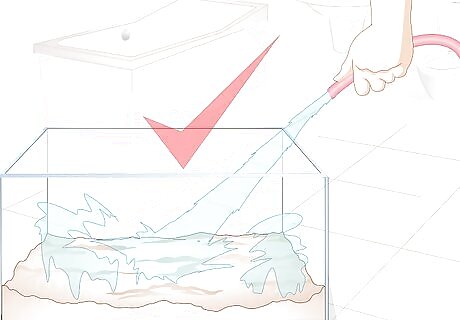
Rinse out the tank. Splash water over the tank with the hose or bathtub, being sure to remove all residue from the cleaning agent and leftover debris. Rinse all sides of the tank until there is no scent of either the vinegar or bleach remaining. Dry the outside with a clean towel.
Refilling the Tank
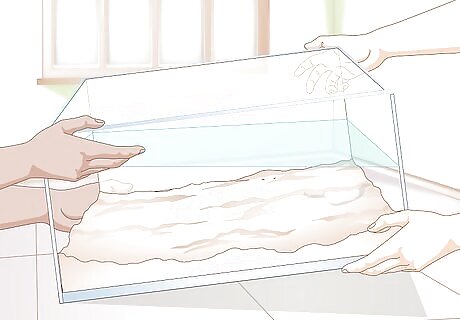
Return the tank. Next, slowly carry the tank back to to its display area, being sure to have someone help you. Then replace all objects in the tank, being careful to reinstall the electric devices securely. Try to redo the tank arrangement as closely as possible to the way it was before the cleaning. This will prevent disorienting and causing stress for your turtle when it is returned to the tank. Make sure to dry the tank with a clean towel before carrying it. This will prevent it from slipping out of your hands when trying to grip it.
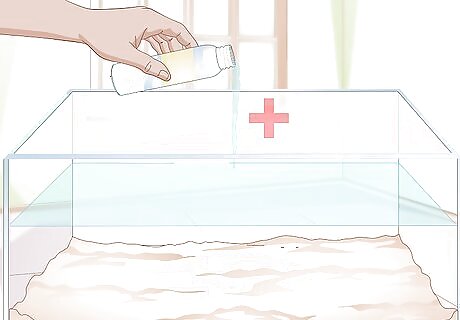
Dechlorinate the new water. Your tap water may contain a level of chlorine that could be harmful to your turtle. But this can be controlled by adding an animal-safe water dechlorinator, available at the pet store.This is especially important if you have used bleach to clean the tank, as this will neutralize any remaining chlorine residue that could harm your pet. Refill the tank using a clean bucket that you fill from the bathtub faucet.
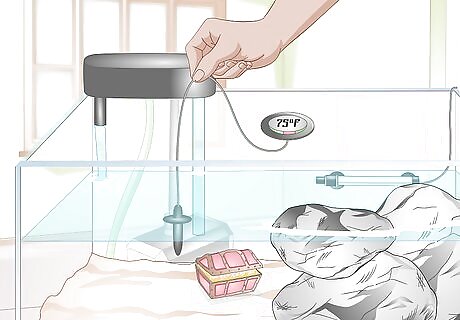
Check water temperature. The temperature of the tank water should be about 70 to 75 degrees Fahrenheit (21-26.6 degrees Celsius). This is about average room temperature, so if the water is too warm or too cold, wait a half an hour and check the temperature again. If the water is too cold, use a water heater to raise the temperature.
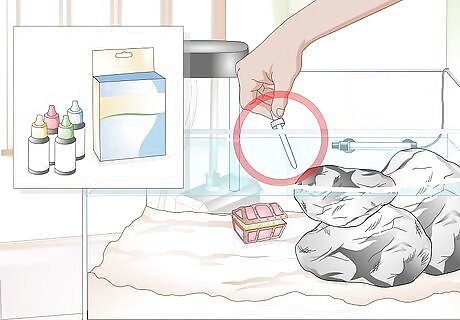
Use testing kits to measure chemical levels. It is important to make sure that pH, ammonia, nitrite, and nitrate levels are in a safe range for your turtle. You can get a testing kit for each of these components at the pet store. Testing typically involves combining a small amount of tank water with a solution in a test tube, which produces a water color that indicates the chemical level. The pH level should generally be between 7 and 8 for most turtles. But certain turtles have specific pH requirements. Be sure to ask an expert at the pet store about the precise pH level your turtle requires. If any chemical level is not in the acceptable range, you can buy additives that will raise or lower the levels of each component.
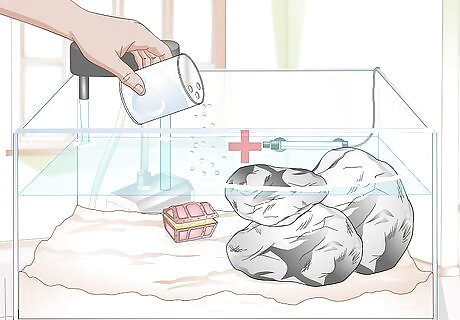
Add some salt. Mix in one teaspoon of non-iodized salt per gallon of tank water. This can help to cut down the amount of harmful bacteria in the tank. It can also aid in protecting your turtle from skin and shell diseases.
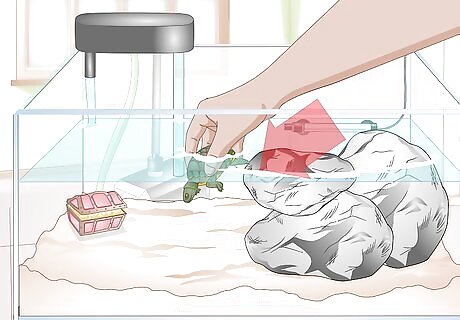
Return the turtle to the tank. Gently put your patient turtle back on its favorite resting spot. Reward it with a treat like a nice worm, some lettuce, or another favorite food. After everything is returned to the tank, clean your hands well with a strong antibacterial soap.


















Comments
0 comment